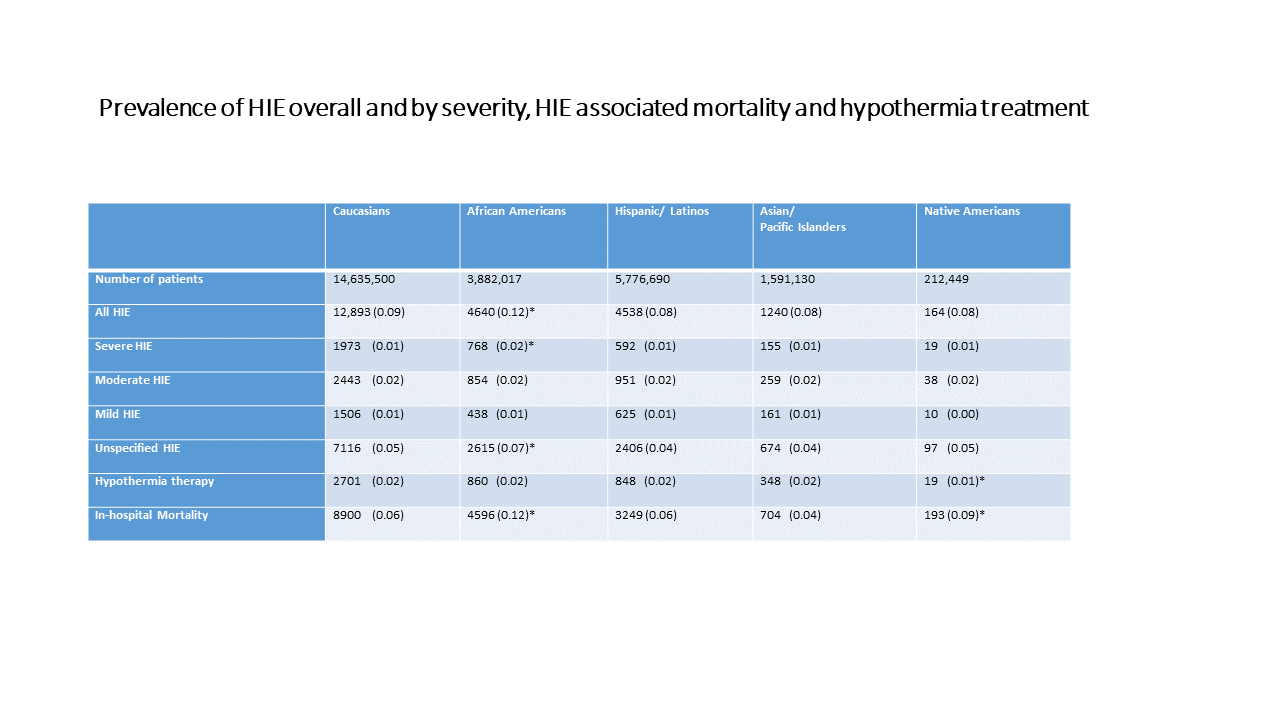Neonatal-Perinatal Health Care Delivery: Epidemiology/Health Services Research
Neonatal-Perinatal Health Care Delivery 2: Epi/HSR Equity
630 - Racial Disparities in Neonatal Hypoxic Ischemic Encephalopathy
Publication Number: 630.141
- CA
Ceyda Acun, MD (she/her/hers)
Associate Staff
Cleveland Clinic Children's
Cleveland Clinic Children's Hospital
Cleveland, Ohio, United States
Presenting Author(s)
Background:
Hypoxic ischemic encephalopathy (HIE) of any degree occurs at a rate of about 1 in 1000 live birth in the United States. Racial disparities in neonatal outcomes have been shown in all-cause mortality and other morbidities. It is not known if racial disparities exist in association with HIE.
Objective:
To examine racial disparities in HIE prevalence, intervention, and outcomes in newborn infants.
Design/Methods:
The de-identified National Inpatient Sample produced by the Health Cost and Utilization Project for the years 2010-2018 was used for this analysis. Infants equal to or more than 37 weeks gestational age (GA) and 2500g birth weight (BW) were included. Eligible sample was divided into groups by race/ethnicities and were compared to Caucasian infants regarding the prevalence of HIE of all types, HIE by severity (mild, moderate, or severe), death associated with HIE, and receiving hypothermia intervention. Logistic regression analysis was used to calculate adjusted OR (aOR) of outcomes while controlling for confounders.
Results:
There were 31,249,100 newborns in the sample. Female infants represented 48.8%, singleton deliveries occurred in 98.6% and cesarean deliveries occurred in 31.1%. Caucasians were 46.8%, African Americans were 12.4%. Hispanic/Latinos were 18.5%, Asians and Pacific Islanders were 5.1%, Native Americans were 0.7%, other and unknown race were 16.5%. Compared to Caucasians, African American neonates had 60% higher chance to have HIE: aOR 1.60 (1.52-1.69, p< 0.001). However, there was no clinically significant disparities observed between Hispanic/Latino, Asian/PI or Native American neonates compared to Caucasians. African American neonates were as twice to have severe HIE and 50% more to have unspecified HIE compared to Caucasian neonates, aOR 2.06 (1.77-2.39, p< 0.001) and 1.57 (1.47-1.68, p< 0.001), respectively. There was no difference between groups regarding hypothermia treatment except for Native Americans who had the lowest chance to receive such intervention compared to all other groups. Mortality was variable, with African Americans to have highest mortality compared to Caucasians, followed by Native Americans, aOR 2.14 (2.02-2.26, p< 0.001), 1.84 (1.50-2.27, p< 0.001), respectively, table (1).
Conclusion(s):
Racial disparities in the prevalence of HIE, mortality due to HIE and hypothermia treatment exist and mostly affecting African American neonates followed by Native Americans.
